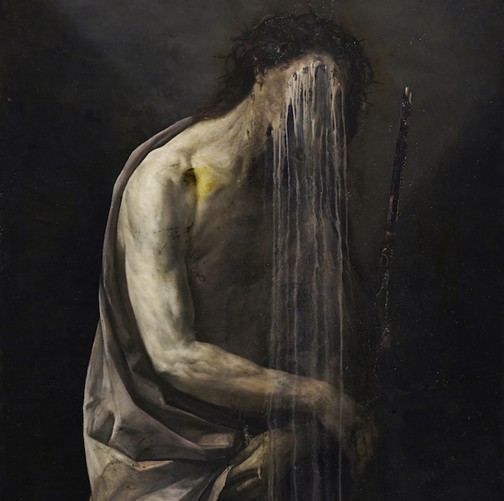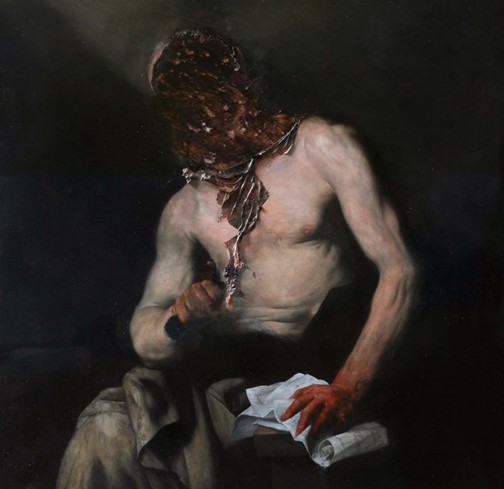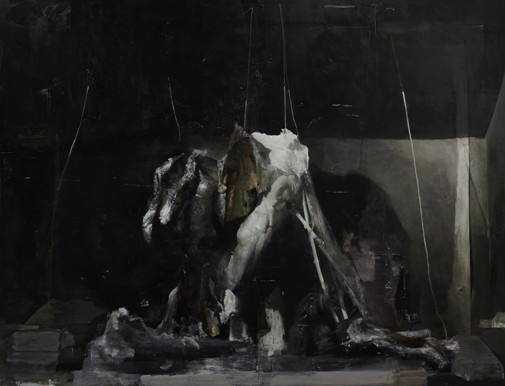
Nicola Samori: l’age mûr @ rosenfeld porcini London
Nicola Samori’s new body of works, currently on show at Rosenfeld Porcini, conceals the enigmatic idiosyncrasy of his depicted subject matter. Human figures suspended from their corporeal identity are vigorously metamorphosed into pictorial hybridised forms. Pastiching old-masterly portraiture, Samori’s provocative media interventions embrace a unique dialogue between an old and well-known iconography and a contemporary rendering.
Encompassing a variety of media such as linen, wood, marble and copper, Samori demonstrates an immense interest in exploring the physical as well as the metaphysical dimension of the human existence. Being a very skillful painter and sculptor, he meticulously pays attention to every single detail in the portrayal of the human body while he concurrently promulgates its fragility and frailty.
Samori has been acquainted with the aesthetics of Rembrandt, Chaim Soutine, Francis Bacon and Marlene Dumas, who undoubtedly had a large impact on him. In his world, beauty is unorthodoxically displaced by the macabre and the grotesque. While the deconstruction of flesh manifests a commentary on the ephemeral and despite the employed monotonous and claustrophobic environments, the subtle approach to the notion of life’s cycle somehow induces an atmosphere of tranquillity and ataraxy.
Flirting with a highly expressionistic modus operandi, Samori masters the psychological value of his heroes and successfully establishes an equilibrium; that of life and death, in a unique abstract fashion and philosophical mode.

Nicola Samori talked to REVma -/+ about his exhibition and work:
REVma -/+: The current exhibited body of work is an homage to Old -and more recent- Masters with a strong personal intervention. Is there, if at all, a fine line between ‘traditional’ and contemporary art aesthetics?
N.S.: The exhibition is divided into two distinct sections: the lower level of the gallery is seen as an immersion in a museum context, achieved through explicit quotes, ranging from antique sculpture to Flemish and baroque painting. The ground floor aims to stimulate the imagination through recent and ancient forms without any precise references. The two parts of the exhibition are united by the materials which generate the images rather than by its subject. Contemporary aesthetics have become a form of tradition, in fact there are already elements of mannerism. I feel most at ease working within areas which have been previously digested by others and explored in every possible direction. It is through this usury of these forms that my gestures take place, groping in time.
REVma -/+: The element of form deconstruction is evident throughout your exhibited pieces. Do you feel that there is a balance between the roles of life and death in your narrative?
N.S.: A painting and a sculpture are machines that imitate life. For this very reason they become the place for an exchange between the becoming of a form and the losing of it, between entering the world and leaving it.

REVma -/+: Your works encompass an array of media including wax, marble, copper, linen and paint. Does your chosen narrative echo the employment of certain media?
N.S.: The choice of medium influences every subsequent development. The only possible way to rediscover the image which has disappeared under the brush stroke is if one adopts clear supports and then flays them as if scraping the oil back to the primer state thereby returning to white. This is only possible with the canvas. Every real development in my path is the result of a misunderstanding with the material.
REVma -/+: Are you currently experimenting on new media and narratives?
N.S.: I am trying to paint the gesture; I am trying to draw the oil.
